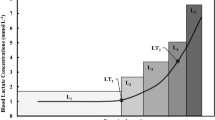Summary
A CO2 rebreathing technique was used to assess possible changes in the ventilatory response to CO2 in rats following a 14-week swim training program. Over the final 9 weeks, the rats swam 1 h per day with a weight of 2.5% of the body weight attached to the tail. Ventilation was measured by a barometric method in awake, restrained rats in a total body plethysmograph at CO2 concentrations of 0, 2, 4, 6, and 8%, with an initial O2 concentration of approximately 100%. Ventilation increased in the trained rats with increasing CO2 from 775 ml·min−1·kg−1 at 0% CO2 to 1,387 ml·min−1·kg−1 at 8% CO2. This increase was a consequence of a 34% increase in tidal volume and a 32% increase in breathing frequency. In comparison with a group of sedentary control rats, there was a significantly higher ventilation and tidal volume at 0% CO2; however, this difference disappeared with increasing levels of CO2. A significantly lower resting heart rate was observed in the exercised (296±44 beats·min−1, mean±SD) compared to the sedentary control rats (380±42). It was concluded that, while the normal training response of resting bradycardia was observed following this duration and intensity of training, endurance swimming had no significant effect on the ventilatory response to CO2 in the rat.
Similar content being viewed by others
References
Bolter CP, Hughson RL, Cirtz JB (1973) Intrinsic rate and cholinergic sensitivity of isolated atria from trained and sedentary rats. Proc Soc Exp Biol Med 144: 364–367
Byrne-Quinn E, Weil JV, Sodal IE, Filley GF, Grover RF (1971) Ventilatory control in the athlete. J Appl Physiol 30: 91–98
Drorbaugh JE, Fenn WO (1955) A barometric method for measuring ventilation in newborn infants. Pediatrics 16: 81–86
Hughson RL, Sutton JR, Fitzgerald JD, Jones NL (1977) Reduction of intrinsic sinoatrial frequency and norepinephrine response of the exercised rat. Can J Physiol Pharmacol 55: 813–820
Lai YL, Tsuya Y, Hildebrandt J (1978) Ventilatory responses of acute CO2 exposure in the rat. J Appl Physiol 45: 611–618
Martin BJ, Weil JV, Sparks KE, McCullough RE, Grover RF (1978) Exercise ventilation correlates positively with ventilatory chemoresponsiveness. J Appl Physiol 45: 557–564
Miyamura M, Yamashina T, Hondo Y (1976) Ventilatory responses to CO2 rebreathing at rest and during exercise in untrained subjects and athletes. Jpn J Physiol 26: 245–254
Oscai LB, Mole PA, Holloszy JO (1971) Effects of exercise on cardiac weight and mitochondria in male and female rats. Am J Physiol 220: 1944–1948
Read DJC (1967) A clinical method for assessing the ventilatory response to CO2. Aust Ann Med 16: 20–32
Rebuck AS, Jones NL, Campbell EJM (1972) Ventilatory response to exercise and to CO2 rebreathing in normal subjects. Clin Sci 43: 861–867
Rebuck AS, Read J (1971) Patterns of ventilatory response to CO2 during recovery from severe asthma. Clin Sci 41: 13–21
Saunders NA, Leeder SR, Rebuck AS (1976) Ventilatory response to carbon dioxide in young athletes. A family study. Am Rev Respir Dis 113: 497–502
Stegemann J, Seez P, Kremer W, Boning D (1975) A mathematical model of the ventilatory control system to carbon dioxide with special reference to athletes and non-athletes. Pfluegers Arch 356: 223–236
Author information
Authors and Affiliations
Additional information
This research was funded in part by grants from the University of Waterloo Research Foundation, the Ontario Heart Foundation, and the Medical Research Council of Canada
Rights and permissions
About this article
Cite this article
Hughson, R.L. Ventilatory CO2 response in endurance-trained rats. Europ. J. Appl. Physiol. 45, 103–108 (1980). https://doi.org/10.1007/BF00421317
Accepted:
Issue Date:
DOI: https://doi.org/10.1007/BF00421317




